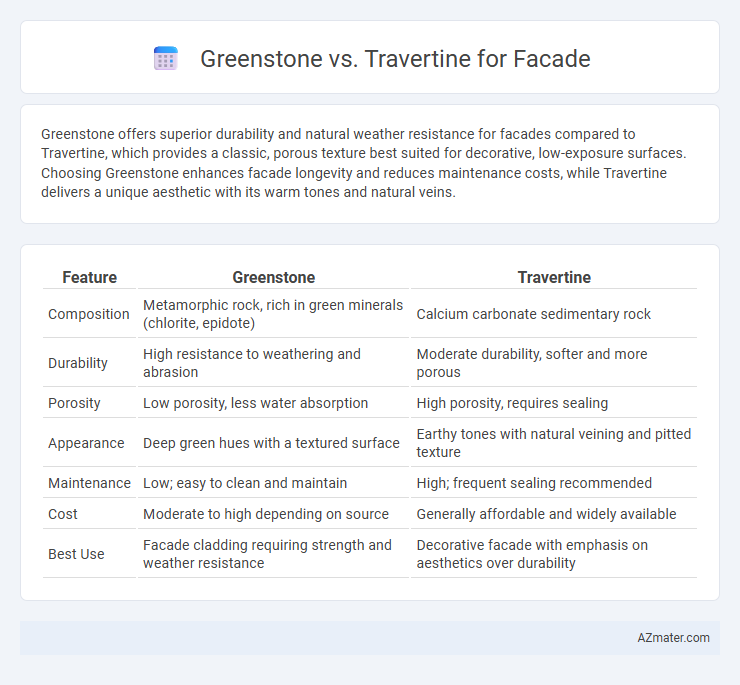Greenstone offers superior durability and natural weather resistance for facades compared to Travertine, which provides a classic, porous texture best suited for decorative, low-exposure surfaces. Choosing Greenstone enhances facade longevity and reduces maintenance costs, while Travertine delivers a unique aesthetic with its warm tones and natural veins.
Table of Comparison
| Feature | Greenstone | Travertine |
|---|---|---|
| Composition | Metamorphic rock, rich in green minerals (chlorite, epidote) | Calcium carbonate sedimentary rock |
| Durability | High resistance to weathering and abrasion | Moderate durability, softer and more porous |
| Porosity | Low porosity, less water absorption | High porosity, requires sealing |
| Appearance | Deep green hues with a textured surface | Earthy tones with natural veining and pitted texture |
| Maintenance | Low; easy to clean and maintain | High; frequent sealing recommended |
| Cost | Moderate to high depending on source | Generally affordable and widely available |
| Best Use | Facade cladding requiring strength and weather resistance | Decorative facade with emphasis on aesthetics over durability |
Introduction to Greenstone and Travertine Facades
Greenstone facades offer a durable, weather-resistant surface with a distinctive greenish hue derived from minerals like chlorite and epidote, making them ideal for contemporary architectural designs. Travertine facades provide a timeless, elegant appearance characterized by natural porous textures and earthy beige tones, widely used in Mediterranean and classical architecture. Both materials enhance building exteriors with unique aesthetic qualities and robust structural benefits suitable for diverse climatic conditions.
Geological Origins and Composition
Greenstone, formed from metamorphosed basaltic rocks, consists primarily of chlorite, actinolite, and epidote minerals that provide its characteristic green hue and durability, making it a resilient choice for facades. Travertine originates from the precipitation of calcium carbonate in mineral-rich hot springs or limestone caves, composed mainly of calcite with a porous, fibrous texture that offers a distinct aesthetic appeal but requires sealing for weather resistance. The geological formation of greenstone imparts higher density and strength, whereas travertine's sedimentary origin results in lighter weight and unique vein patterns suitable for decorative facade applications.
Visual Appeal: Color, Texture, and Finish
Greenstone offers a deep, rich green hue with subtle variations that create a natural, luxurious appearance, ideal for facades seeking earth-toned elegance. Travertine features warm beige and cream tones with a porous, textured surface that adds timeless character and softness to building exteriors. The polished finish of greenstone contrasts with the typically honed or tumbled finish of travertine, providing architects with distinct options for achieving either sleek modernity or classic rustic charm.
Durability and Weather Resistance
Greenstone exhibits high durability and exceptional weather resistance, making it ideal for facades exposed to harsh climates and moisture. Travertine, while aesthetically appealing with its natural texture, is more porous and requires sealing to prevent weather-induced wear and erosion. Choosing greenstone ensures lower maintenance and longer lifespan for outdoor facade applications due to its robust mineral composition and resistance to freeze-thaw cycles.
Maintenance Requirements
Greenstone facades require minimal maintenance due to their natural durability and resistance to weathering, making them suitable for long-term exterior applications. Travertine, while aesthetically appealing, demands more frequent sealing and cleaning to prevent staining, especially in areas exposed to moisture and pollution. Choosing greenstone reduces maintenance efforts and costs, whereas travertine needs consistent upkeep to preserve its appearance on building facades.
Environmental Impact and Sustainability
Greenstone offers a lower environmental impact for facades due to its abundant local availability and minimal processing requirements, reducing carbon emissions during extraction and fabrication. Travertine, while natural and durable, often involves energy-intensive quarrying and transportation, contributing to a higher carbon footprint. Choosing greenstone supports sustainability by minimizing resource depletion and promoting eco-friendly construction practices in facade design.
Cost Comparison and Value
Greenstone facades typically involve higher initial costs due to their rarity and complex extraction processes, while travertine offers a more affordable option with widespread availability. Despite the premium price, greenstone adds unique aesthetic value and durability that can increase property value over time. Travertine remains a cost-effective choice, balancing visual appeal and maintenance benefits for budget-conscious projects.
Installation Process and Challenges
Greenstone facades require specialized cutting and anchoring techniques due to the stone's dense composition, often demanding skilled labor and precise handling to prevent cracking. Travertine installation involves managing its porous surface by sealing the stone and ensuring proper mortar application to avoid moisture penetration and staining. Both materials pose challenges with weight management, but Greenstone typically requires stronger structural support compared to the lighter Travertine panels.
Popular Applications in Modern Architecture
Greenstone and travertine are popular facade materials in modern architecture, valued for their durability and aesthetic appeal. Greenstone is favored for its rich green hues and structural strength, making it ideal for contemporary commercial buildings and luxury residences seeking a natural yet elegant finish. Travertine, known for its warm beige tones and porous texture, is commonly used in residential facades and cultural institutions to create timeless, sophisticated exteriors with excellent weather resistance.
Choosing the Right Stone for Your Facade
Choosing the right stone for your facade involves evaluating the durability, aesthetic appeal, and maintenance requirements of Greenstone and Travertine. Greenstone offers exceptional strength and weather resistance, making it ideal for harsh climates, while Travertine provides a unique, porous texture and warm tones that enhance architectural elegance. Prioritize factors like environmental exposure, desired visual impact, and long-term upkeep to determine the best stone for your facade project.

Infographic: Greenstone vs Travertine for Facade
 azmater.com
azmater.com